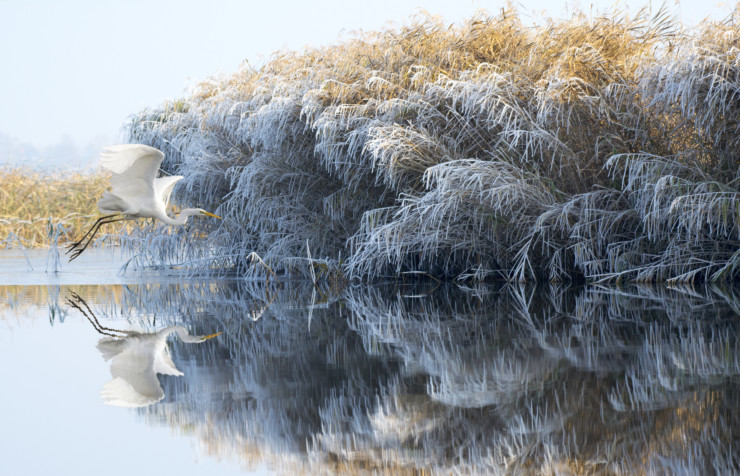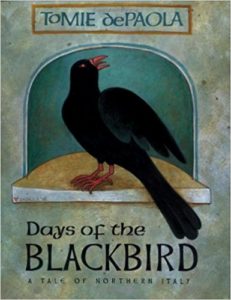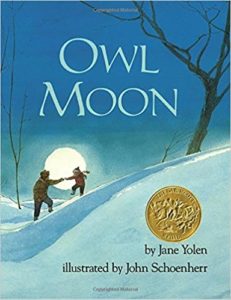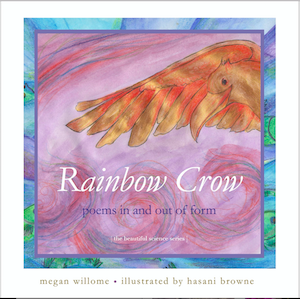My birthday is January 29. Because of an encounter we had with a crow when my son was a child, I’ve loved all black birds ever since. Imagine my joy when I learned that the last three days of January are known as Days of the Blackbird — traditionally, the coldest days of the year.
Why do those days have that designation? To answer the question, we need a folktale.
So, what is the difference between a folktale, a legend, a fable, and a fairy tale? There are distinctions, but, to sum up, these are all old stories, retold. The master of retelling them (and illustrating them) is Tomie dePaola.
Honored with the Laura Ingalls Wilder Medal for lifetime achievement in children’s literature, dePaola is a writer and illustrator of more than 260 books. He’s a master of the folk tale, the legend, and the lives of Catholic saints, and he has also created fine art for the Glastonbury Abbey in Hingham, Massachusetts. His best-known book is Strega Nona, a Caldecott honor-winner about an old woman and her magical pot of pasta. At one time he owned an Airedale named Bronte, so he’s a good fella in my book. DePaola is 83 and has a new book coming out in April.
I have always loved old stories, especially ones from other countries. This one hails from northern Italy, and in the Author’s Note, dePaola specifies where exactly it takes place: “in the little village of Sabbia, near the town of Varallo-Sesia, in northern Italy. Sabbia is nestled into a hill, with high mountains all around, just as I have pictured it on the title page.” Specificity, the heart of story, is also the heart of art.
This old story covers two traditions. The first is why the last three days of January are called the Days of the Blackbird, Le Giornate della Merla, and the second is why doves nest in chimney tops during the winter. To answer these questions, dePaola adapts another fairy tale, The Nightingale. In his retelling, it is a story about a duke and his daughter and the birds they love, and about how La Colomba, a dove, becomes La Merla, a blackbird.
Kirkus Reviews called dePaola’s art in this story “fresco-style,” and that’s a fitting description. It feels like we’re in the duke’s castle, wandering from room to room, viewing frescoes of this ancient tale. And the text is sprinkled with Italian words — il concerto, Natale, panettone, la primavera — and the meaning is clear, either from context, or it is defined outright.
Duca Gennaro and his daughter Gemma enjoy watching and listening to the brightly colored birds that visit their courtyard. Their favorite is La Colomba. In winter, when the birds fly south, the duke and Gemma miss them.
One year Duca Gennaro falls ill, and Gemma comes every afternoon to open the windows so he can hear the birds. When cold weather comes and it’s time for the birds to fly away, Gemma coaxes them to stay. But by arrival of Epiphania, the Feast of the Three Kings, only La Colomba remains.
“She started to sing her song and did not stop until darkness fell.”
By the end of January it is frigid. La Colomba still sings, nesting in the chimney to keep warm.
“She left only to eat and to sing for Duca Gennaro.”
The soot turns La Colomba’s feathers black. She is now La Merla. Gemma is surprised, but she recognizes the black bird by the way it sings.
“But when the bird’s song filled the room, she knew it was La Colomba.”
Which got me to thinking: What are we willing to suffer if our art saves someone else?
“The Duke opened his eyes and sat up for the first time in three days. He was weak but whispered, ‘My birdsong.’”
If we knew our art could save a life but we would remain permanently changed, would we acquiesce?
“But La Colomba remained La Merla. Her feathers were never white again.
When the first warm day comes, La Merla is waiting for Gemma and her father.
“From that year on, La Colomba would be known as La Merla, and all her children would be as well.”
This line raises an even deeper question: Would we say yes to suffering if we knew it would also impact our children?
“To honor her, Duca Gennaro proclaimed that the last three days in January would thenceforth be known as Le Giornate della Merla, the Days of the Blackbird.”
There are many ways to read this tale. We could focus on the relationship between the duke and his daughter. We could look at the kind way the duke rules the town. We could notice how Gemma sits in her father’s chair on Christmas morning. We could examine the power of music. We could search for the one bird of many colors among the illustrations. We could also talk about winter and how we cope with scenes like this one: “Bitter winds swirled around the mountain peaks, and the houses shuddered with the cold.”
That’s why I love old stories. Their simple words allow space for us to think and wonder about our own lives.
This year January 29, 30, 31 fall on a Monday, Tuesday, and Wednesday. Regardless of the weather, take some time to listen for the song of the blackbirds. You might find them waiting for you.
_______________
The next Children’s Book Club will meet Friday, February 12: We will read Owl Moon, written by Jane Yolen and illustrated by John Schoenherr.
Photo by Artur Rydzewski, Creative Commons via Flickr. Post by Megan Willome, author of The Joy of Poetry.
Browse more Children’s Book Club
“Megan Willome has captured the essence of crow in this delightful children’s collection. Not only do the poems introduce the reader to the unusual habits and nature of this bird, but also different forms of poetry as well.”
—Michelle Ortega, poet and children’s speech pathologist
- Perspective: The Two, The Only: Calvin and Hobbes - December 16, 2022
- Children’s Book Club: A Very Haunted Christmas - December 9, 2022
- By Heart: ‘The night is darkening round me’ by Emily Brontë - December 2, 2022




Megan Willome says
P.S. Here’s a YouTube reading of the story, if you haven’t made it to the library yet.
Michelle Ortega says
Oh Megan, I am a fan of Tomie dePaola-“Sing, Pierrot, Sing,” and “Nana Upstairs, Nana Downstairs.” The loyalty and devotion of La Merla moves me.
Megan Willome says
Hi, Michelle! I have read Nana Upstairs, Nana Downstairs (there are echoes of it in the movie “Coco”), but have not read Sing, Pierrot, Sing. It looks fascinating.
Sandra Heska King says
I *did* watch/listen to that reading. 🙂
I loved hearing the narrator pronounce the Italian words. I’ve been going to physical therapy, and my therapist is Italian. Her parents and siblings came from Italy and settled in Chicago before she was born. She talked about struggling to learn the English language and how humiliated she felt when she had to read aloud in class. The teacher told her she needed others to read to her, but her older siblings were struggling, too. Maria used to sneak out of the house through a window and go across the street where her older sister’s friend would read to her. (She’d get in trouble for it, too, cuz her parents were very strict.) Anyway, she taught me yesterday how to say “ricotta.” It’s not rye-cah’tah like I *used to* say it. It’s “re-coat’-a” with a trill. So that has nothing to do with the book, but…
I felt that cold and bitter winter and imagined how cold it must have been even with a fire in the great hall. This is definitely a sweet story of kindness and love and sacrifice I was so afraid La Colomba or the duke or both would die.
And now your questions have me thinking… What are we willing to suffer if our art saves someone else? Would we say yes to suffering if we knew it would also impact our children?
Megan Willome says
How wonderful, Sandy, that you have a connection with the Italian words in this story.
And yes, it’s nice when a story has a happy ending.
Kortney Garrison says
Thanks for pulling out the connection between the dove’s singing and art making–adds another layer to the dove’s song. I wonder if the Days of the Blackbird will really be the coldest of the year?! Loved sharing this story.
Megan Willome says
Thanks, Kortney!
I read that if the Days of the Blackbird are the coldest of the winter, then spring will come on time and be beautiful. If the days are mild, then spring will be icky. (Sort of like Groundhog Day.)
Kortney Garrison says
Oh I love that! Those bits of old weather lore are instructive…even if not always accurate! 😉